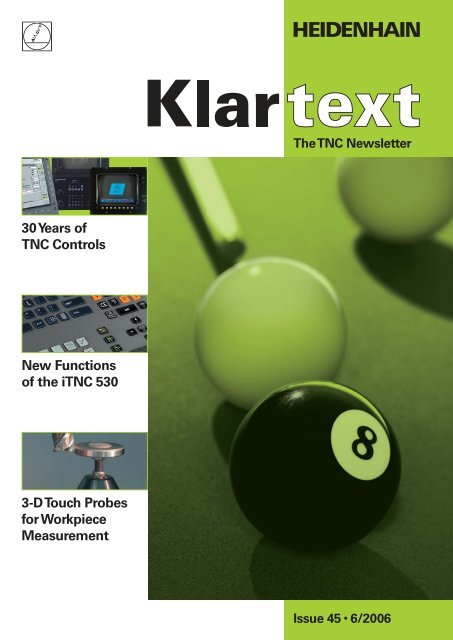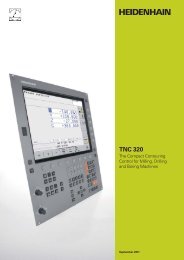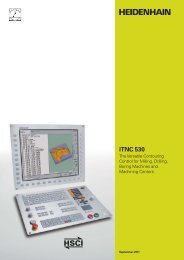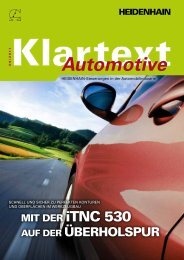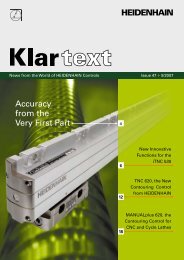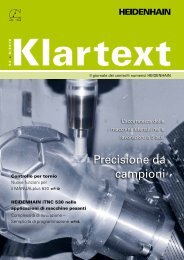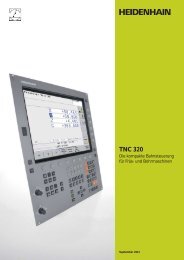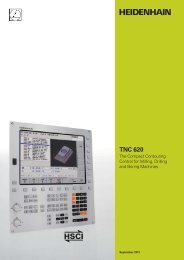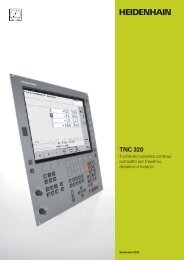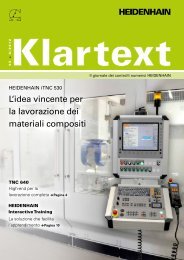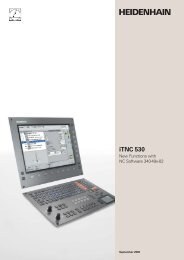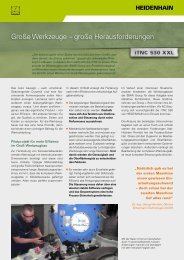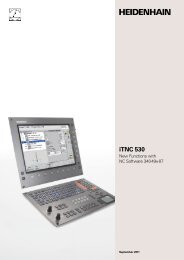The TNC Newsletter - TNC 640 - DR. JOHANNES HEIDENHAIN ...
The TNC Newsletter - TNC 640 - DR. JOHANNES HEIDENHAIN ...
The TNC Newsletter - TNC 640 - DR. JOHANNES HEIDENHAIN ...
Create successful ePaper yourself
Turn your PDF publications into a flip-book with our unique Google optimized e-Paper software.
30 Years of<br />
<strong>TNC</strong> Controls<br />
New Functions<br />
of the i<strong>TNC</strong> 530<br />
3-D Touch Probes<br />
for Workpiece<br />
Measurement<br />
<strong>The</strong> <strong>TNC</strong> <strong>Newsletter</strong><br />
Issue 45 6/2006
Page 2<br />
Editorial<br />
Dear Klartext Reader,<br />
30 years of <strong>TNC</strong> control. To us these are<br />
proud words. <strong>The</strong> number of controls<br />
shipped is also considerable—the<br />
190,000th will be shipped this year! And<br />
regular <strong>TNC</strong> courses have been conducted<br />
here in Traunreut for some 25 years now.<br />
Every year, approximately 1000 participants<br />
take advantage of an extensive training<br />
curriculum.<br />
At the METAV, too, there will be an<br />
impressive number of innovations around<br />
the i<strong>TNC</strong> 530! <strong>The</strong> topics of this year’s<br />
METAV include the introduction of<br />
Dynamic Collision Monitoring (DCM) and<br />
the capability to process dxf fi les immediately<br />
with the i<strong>TNC</strong>, as well as other<br />
improvements in user friendliness, for<br />
example the handy <strong>TNC</strong>guide help system.<br />
You’ll fi nd further information starting on<br />
page 6.<br />
On page 12 we report on an interesting<br />
improvement in our touch probe product<br />
line. <strong>The</strong> contact-free laser systems and<br />
the TT 140 now provide a comprehensive<br />
product range for tool calibration.<br />
<strong>The</strong> article on the Deuringer Maschinenbau<br />
OHG shows how retrofi tting can guarantee<br />
higher profi tability.<br />
Have a good read! And let us know what<br />
you think of it.
Klartext—<strong>The</strong> <strong>TNC</strong> <strong>Newsletter</strong> · Issue 45 · 6/2006 Page 3<br />
Contents<br />
30 Years of <strong>TNC</strong> Controls 4<br />
New Functions for the i<strong>TNC</strong> 530 6<br />
New E-Learning Module<br />
“Fundamentals of Machining in Tilted Working Planes” 9<br />
25 Years of Technical Training 10<br />
3-D Touch Probes for Tool Measurement 12<br />
User Report:<br />
Once <strong>TNC</strong>—Always <strong>TNC</strong> 14<br />
Publisher<br />
<strong>DR</strong>. <strong>JOHANNES</strong> <strong>HEIDENHAIN</strong> GmbH<br />
Postfach 1260<br />
D-83292 Traunreut, Germany<br />
Tel: +49 (8669) 31- 0<br />
www.heidenhain.de<br />
info@heidenhain.de<br />
Editor<br />
Frank Muthmann<br />
Production<br />
Klartext on the Internet<br />
www.heidenhain.de/klartext
Page 4<br />
30 Years of <strong>TNC</strong> Controls<br />
This year <strong>HEIDENHAIN</strong> will ship its<br />
190,000th NC control. This is a remarkable<br />
achievement after a 30-year history of<br />
development.<br />
Thirty years of <strong>TNC</strong> development<br />
Thirty years ago—in 1976—<strong>HEIDENHAIN</strong><br />
began developing the fi rst <strong>TNC</strong> control,<br />
the <strong>TNC</strong> 110, which was displayed at the<br />
FAMETA in Stuttgart in October 1976. All<br />
of three <strong>TNC</strong> 110 controls were sold. Its<br />
successor, the <strong>TNC</strong> 120, already featured<br />
a program memory with 64 program steps<br />
and sold a total of 70 units.<br />
<strong>The</strong> successor model <strong>TNC</strong> 121 was already<br />
available in the fall of 1977. <strong>The</strong> <strong>TNC</strong> 121<br />
was equipped with a memory of 128<br />
blocks for program part repeats and<br />
subprogramming. <strong>The</strong> program memory<br />
was battery buffered, which ensured that<br />
the entered programs stayed in memory<br />
even after the machine was switched off.<br />
With the <strong>TNC</strong> 121 <strong>HEIDENHAIN</strong> attained<br />
total sales of 6200 units, which effectively<br />
marked the beginning of the <strong>TNC</strong> success<br />
story.<br />
<strong>The</strong> fi rst contouring control<br />
<strong>The</strong> fi rst contouring control—the <strong>TNC</strong><br />
145—was introduced at the EMO 1981,<br />
followed two years later by the <strong>TNC</strong> 150,<br />
a contouring control with four axes and<br />
integrated PLC. In 1984, the <strong>TNC</strong> 155 came<br />
on the market—the fi rst <strong>HEIDENHAIN</strong><br />
control with graphic simulation of the<br />
machining process. It was also the fi rst<br />
to permit G-code programming according<br />
to ISO 6983 (DIN 66025) in addition to<br />
conversationally guided plain language<br />
programming. This gave the <strong>TNC</strong> excellent<br />
qualifi cations both for shop-fl oor and offl ine<br />
programming.<br />
With the <strong>TNC</strong> 355 in 1987, <strong>HEIDENHAIN</strong><br />
separated the keyboard from the logic unit.<br />
At the 1989 EMO in Hanover, an entirely<br />
new generation of controls was<br />
introduced: the <strong>TNC</strong> 415 with 32-bit<br />
processors, color screen and alphabetic<br />
keyboard.<br />
Integrated motor control<br />
<strong>HEIDENHAIN</strong> has been working with<br />
digital motor control since 1989. First, the<br />
velocity controller was integrated in the<br />
<strong>TNC</strong>, thereby allowing the advantages<br />
of digital velocity controller to be used<br />
together with analog inverters. This<br />
control—the <strong>TNC</strong> 425—was presented in<br />
Paris at the EMO 1991. In the fall of 1994,<br />
<strong>HEIDENHAIN</strong> came forward with the<br />
<strong>TNC</strong> 426 and made a further step toward<br />
integration: with the velocity and current<br />
controller all elements of drive control were<br />
incorporated in the <strong>TNC</strong>. <strong>The</strong> product line<br />
was expanded to include motors and<br />
inverters.<br />
<strong>The</strong> introduction of the i<strong>TNC</strong> 530 at the<br />
EMO 2001 heralded a new age in <strong>TNC</strong><br />
controls—with an entirely new hardware<br />
architecture. It continues the successful<br />
<strong>TNC</strong> contouring control idea and, with its<br />
short block processing times and optimum<br />
path control, sets new standards in high<br />
speed machining.
Klartext—<strong>The</strong> <strong>TNC</strong> <strong>Newsletter</strong> · Issue 45 · 6/2006 Page 5<br />
Since the EMO 2005, the compact contouring<br />
control <strong>TNC</strong> 320 is available as an<br />
alternative to the i<strong>TNC</strong> 530 for installation<br />
on simple 3-axis machines, on boring<br />
machines, and for retrofi tting.<br />
smarT.NC<br />
<strong>The</strong> new smarT.NC operating mode, which<br />
was presented at the METAV 2004, is yet<br />
another step forward toward greater ease<br />
of use. smarT.NC continues the success<br />
story of this shop-fl oor programmable user<br />
interface. Well-structured input forms,<br />
straightforward graphic support, and<br />
comprehensive help texts combine with<br />
the easy-to-use pattern generator to form a<br />
compelling programming environment.<br />
And in spite of smarT.NC’s entirely different<br />
user interface, it stands squarely on the<br />
proven <strong>HEIDENHAIN</strong> plain language dialog.<br />
Because in the background—out of view<br />
for the user—smarT.NC generates the<br />
program in conversational format.<br />
<strong>The</strong> <strong>TNC</strong> in numbers<br />
By the METAV, <strong>HEIDENHAIN</strong> will have<br />
built and shipped its 190,000th NC<br />
control. <strong>The</strong>se comprise about 50<br />
separate models. <strong>The</strong> most successful<br />
among them is the <strong>TNC</strong> 426 with<br />
25,000 units sold since its introduction<br />
in 1994. With over 145,000 units, the<br />
contouring controls comprise about<br />
three fourths of the total number, as<br />
opposed to 45,000 straight cut controls.<br />
In 2006, an estimated 9,000 controls<br />
with leave the factory.
Page 6<br />
New Functions<br />
for the i<strong>TNC</strong> 530<br />
<strong>The</strong> topics of this year’s METAV include the<br />
introduction of Dynamic Collision<br />
Monitoring (DCM) and the capability to<br />
process dxf fi les immediately with the<br />
i<strong>TNC</strong>. Other improvements in user<br />
friendliness include the handy <strong>TNC</strong>guide<br />
help system, which will be available by the<br />
end of 2006 as software version 03.<br />
<strong>TNC</strong>guide help system (FCL3 feature)<br />
<strong>The</strong> i<strong>TNC</strong> 530 numerical control and<br />
i<strong>TNC</strong> 530 programming station now feature<br />
the <strong>TNC</strong>guide, a convenient help system<br />
that can show the user documentation<br />
through a browser. Pressing the HELP key<br />
calls the <strong>TNC</strong>guide, which in some cases<br />
opens at the page appropriate to the<br />
current situation (context-sensitive help).<br />
In addition, you can call the <strong>TNC</strong>guide by<br />
clicking the help command and pointing<br />
with the moving question mark at any soft<br />
key. To activate the question mark symbol,<br />
you simply click the help symbol always<br />
present at the lower right of the <strong>TNC</strong><br />
screen .<br />
With each NC software license,<br />
<strong>HEIDENHAIN</strong> supplies the German and<br />
English documentation. <strong>HEIDENHAIN</strong><br />
provides the other conversational<br />
languages for downloading free of charge<br />
as soon as the translations become<br />
available. After download, you can save the<br />
national language fi les in the corresponding<br />
language directory on the <strong>TNC</strong> partition.<br />
<strong>The</strong> following manuals are available in the<br />
help system:<br />
User’s Manual, conversational<br />
programming<br />
User’s Manual for smarT.NC<br />
User’s Manual for touch probe cycles<br />
User’s Manual for the i<strong>TNC</strong> 530 programming<br />
station (installed only in the<br />
programming station)
Klartext—<strong>The</strong> <strong>TNC</strong> <strong>Newsletter</strong> · Issue 45 · 6/2006 Page 7<br />
Global program settings (option)<br />
<strong>The</strong> global program settings, which come<br />
into play particularly in large-scale mold<br />
making, it is available in the Program Run<br />
Option for Adaptive Feed Control (AFC)<br />
With adaptive feed control (AFC), the feed<br />
rate is automatically regulated by the <strong>TNC</strong><br />
according to the respective utilized<br />
percentage of spindle power. This is done<br />
with the aid of the feed-rate override factor,<br />
which is normally calculated from the<br />
position of the override potentiometer.<br />
When AFC is active, this factor is no longer<br />
derived from the potentiometer, but from<br />
the spindle power and other process data<br />
from which the feed rate is calculated.<br />
In a teach-in cut, the i<strong>TNC</strong> records the<br />
maximum spindle power. <strong>The</strong>n, before<br />
actual machining, you defi ne in a table the<br />
and the MDI mode. It allows you to defi ne<br />
various coordinate transformations and<br />
settings with global and priority effect for<br />
the respectively selected NC program,<br />
without having to edit it.<br />
respective limit values between which the<br />
i<strong>TNC</strong> can infl uence the feed rate in the<br />
adaptive control mode in the “control”<br />
mode. Of course, various overload<br />
reactions can be specifi ed, which can also<br />
be defi ned by your machine tool builder.<br />
Benefi ts of adaptive feed control:<br />
Optimization of the machining time<br />
Particularly on cast parts, fl uctuations<br />
in dimensions or material and blowholes<br />
often appear. With a corresponding<br />
adaptation of the feed rate, the<br />
control tries to keep the previously<br />
"learned" maximum spindle power<br />
during the entire machining time. <strong>The</strong><br />
total machining time is shortened by<br />
You can change the global program settings<br />
in the stopped condition even within a<br />
machining operation. After the <strong>TNC</strong> starts<br />
from this position, it moves, if necessary,<br />
to a changed position with a positioning<br />
logic infl uenced by you.<br />
<strong>The</strong> following functions are available:<br />
Swapping axes<br />
Additive datum shift<br />
Superimposed mirroring<br />
Axis locking<br />
Handwheel superimposition, with axisspecifi<br />
c memory of paths covered per<br />
handwheel<br />
Superimposed basic rotation<br />
Superimposed rotation<br />
Defi nition of a globally effective feed<br />
rate factor<br />
an increased feed rate in the machining<br />
zones with less stock removal.<br />
Tool monitoring<br />
When spindle power consumption is<br />
exceeded at the same time as the feed<br />
rate falls below minimum, the control<br />
responds with a programmed shutdown.<br />
This prevents damage resulting<br />
from tool breakage or wear.<br />
Reduction of machine wear<br />
Reducing the feed rate down to the<br />
reference value whenever the learned<br />
maximum permissible spindle power<br />
is exceeded also reduces the strain<br />
and wear on the machine. It effectively<br />
protects the spindle from overload.
Page 8<br />
New Functions<br />
for the i<strong>TNC</strong> 530<br />
Improvements in the DXF converter<br />
(option)<br />
With the DXF converter you can now also<br />
select machining positions in addition to<br />
contours and save them as a point table.<br />
You can defi ne the following locations as<br />
machining positions:<br />
<strong>The</strong> beginning, end or mid-point of a<br />
line<br />
At the beginning, end or center point<br />
of a circular arc<br />
Quadrant transitions or center point of<br />
a circle<br />
Intersection of two lines, regardless of<br />
whether it is located inside or outside<br />
the programmed segments<br />
Intersection of a line and a circular arc<br />
Intersection of a line and a circle<br />
You can use the point tables generated in<br />
the DXF converter very conveniently in<br />
smarT.NC, however the function is also<br />
available in conversational programming.<br />
<strong>The</strong> selection of contours was simplifi ed as<br />
well. <strong>The</strong> design engineer does not always<br />
defi ne the contours so that they can be<br />
selected directly without manual rework.<br />
For example, now you can separate<br />
laterally joined contour segments that<br />
would otherwise prevent contour<br />
selection. <strong>The</strong> extension and shortening of<br />
contour segments is now also allowed if<br />
the desired element limits are too far apart.<br />
Both functions are always available within<br />
the contour selection mode, by the way, so<br />
you need not decide beforehand which<br />
segments will have to be modifi ed. <strong>The</strong><br />
i<strong>TNC</strong> automatically detects critical places<br />
and indicates with symbols that the<br />
segments have to be separated,<br />
lengthened, or shortened.
Klartext—<strong>The</strong> <strong>TNC</strong> <strong>Newsletter</strong> · Issue 45 · 6/2006 Page 9<br />
Since October 2004, <strong>HEIDENHAIN</strong> has<br />
been a partner in a European project group.<br />
An e-learning project entitled “Modular<br />
Interactive Training System for Vocational<br />
and Distance Training in Mechatronics“<br />
(MITS) is being developed as a part of the<br />
“Leonardo da Vinci”* program.<br />
In this e-learning project, which extends<br />
over three years, members of the Technical<br />
Training department are developing the<br />
content of a web-based training program<br />
on the fundamentals of NC programming,<br />
from which they will prepare the individual<br />
learning modules.<br />
<strong>The</strong> media that form the basis of the elearning<br />
project are interactive, animated<br />
training sequences as well as interactive<br />
comprehension checks and tests with<br />
automatic scoring.<br />
* “Leonardo da Vinci” is a program of<br />
the European Union to promote<br />
vocational training.<br />
New E-Learning Module “Fundamentals<br />
of Machining in Tilted Working Planes”<br />
This type of training is intended<br />
as preparation for group instruction<br />
to supplement group instruction<br />
in the context of self-paced study<br />
<strong>The</strong> following modules have been<br />
completed in German and English:<br />
Fundamentals of NC Programming<br />
Fundamentals of Machining in Tilted<br />
Working Planes<br />
A further learning module is scheduled for<br />
2007. <strong>HEIDENHAIN</strong> plans to produce<br />
additional modules after the project is<br />
concluded.<br />
<strong>The</strong> 2nd module, “Fundamentals of<br />
Machining in Tilted Working Planes”<br />
became available in time for the METAV in<br />
Düsseldorf and is available free of charge<br />
on a “<strong>TNC</strong> Training” CD and for<br />
downloading from the <strong>HEIDENHAIN</strong> web<br />
site.<br />
You can fi nd more information at<br />
www.heidenhain.de/schulung
Page 10<br />
25 Years of Technical Training<br />
When the “Training and Documentation“<br />
offi ce of the Service Department was<br />
founded in 1981, it consisted of a single<br />
man: Hannes Wechselberger. Today there<br />
is a number of professionals working on<br />
the training effort at <strong>HEIDENHAIN</strong> in<br />
Traunreut as well as in locations such as<br />
Fellbach, Hagen, Hanover, and in the<br />
regional agencies.<br />
<strong>The</strong> fi rst offi cial <strong>TNC</strong> programming course<br />
at <strong>HEIDENHAIN</strong> took place in the fall of<br />
1981.<br />
It was intended for employees from our<br />
regional agencies and was on the topic of<br />
the “Use and Repair of the <strong>TNC</strong> 121,<br />
<strong>TNC</strong> 125 and <strong>TNC</strong> 131 Controls.”<br />
<strong>The</strong> instructor for <strong>TNC</strong> programming was<br />
Klaus Loh of the Sales department. (Klaus<br />
began his well earned retirement in 2001<br />
after 27 years with <strong>HEIDENHAIN</strong>.)<br />
Apart from his trusty blackboard, his<br />
resources included an overhead projector<br />
with transparencies and full-fl edged<br />
<strong>HEIDENHAIN</strong> controls. <strong>The</strong> participants<br />
were given paper documentation with<br />
black-and-white illustrations to take home.<br />
Not more than a year later, <strong>HEIDENHAIN</strong><br />
was providing regular <strong>TNC</strong> programming<br />
courses organized by Sales & Marketing<br />
personnel. <strong>The</strong>y were intended primarily for<br />
machine tool builders, retrofi tters and<br />
distributors. At the same time, courses<br />
were conducted—at that time exclusively<br />
for <strong>HEIDENHAIN</strong> agencies—in <strong>TNC</strong> fi eld<br />
service and repair.<br />
By the introduction of the <strong>TNC</strong> 150 in 1983<br />
the range of courses given by Sales<br />
comprised basic and advance courses, and<br />
those conducted by Service were<br />
expanded by the additional topics of PLC<br />
programming, interfacing the <strong>TNC</strong> to the<br />
machine, and encoder service/repair.<br />
In the course of a comprehensive company<br />
restructuring in 1992, <strong>TNC</strong> programming<br />
training and the Service courses were<br />
combined in the “Technical Training”<br />
section of the Service department.<br />
As a result of the situation on the machine<br />
tool market in 1992, the type of participants<br />
changed signifi cantly, particularly in the<br />
<strong>TNC</strong> programming courses. <strong>The</strong> number of<br />
Interested in <strong>HEIDENHAIN</strong> training?<br />
You can inform yourself conveniently on<br />
the Internet at www.heidenhain.de/<br />
schulung. Here you will fi nd not only the<br />
complete program of courses, but also<br />
the number of slots currently available.<br />
From here you can apply directly by email<br />
for a desired course.<br />
You’ll also fi nd addresses for training<br />
sources at <strong>HEIDENHAIN</strong> regional<br />
agencies and at authorized<br />
<strong>HEIDENHAIN</strong> training partners, as well<br />
as links to their home pages.<br />
end users increased dramatically at the<br />
expense of personnel from machine tool<br />
manufacturers, retrofi tters and distributors.<br />
Since 2000, training in <strong>HEIDENHAIN</strong><br />
conversational programming—and in the<br />
new smarT.NC programming—has been<br />
conducted at many locations in Germany,<br />
several other European countries, and in<br />
China and South Africa.<br />
Since mid-2001, courses at <strong>HEIDENHAIN</strong><br />
have been conducted in new training<br />
rooms equipped with state-of-the-art<br />
media technology.<br />
<strong>The</strong> course instructors at <strong>HEIDENHAIN</strong>—<br />
all of them experts in their respective<br />
fi elds—use a beamer and a special “Video<br />
Didact System” for data communication<br />
the participants.<br />
Today, besides the conventional paper<br />
documentation, <strong>HEIDENHAIN</strong> provides the<br />
participants with numerous CD-ROMs and<br />
DVDs.<br />
E-learning programs as CDs or on the<br />
Internet are available to help participants<br />
prepare for <strong>TNC</strong> programming courses. <strong>The</strong>
Klartext—<strong>The</strong> <strong>TNC</strong> <strong>Newsletter</strong> · Issue 45 · 6/2006 Page 11<br />
e-learning programs can be used as a selfteaching<br />
tool. <strong>The</strong>y contain a comprehension<br />
test, and sections of the programs can be<br />
used to accompany courses in progress.<br />
In 2003, the Technical Training department<br />
was assigned to the marketing division.<br />
Now, as a “marketing instrument” it has<br />
gained new signifi cance and additional<br />
tasks.<br />
Today, technical training courses are<br />
conducted at many <strong>HEIDENHAIN</strong> locations<br />
worldwide in the local language.<br />
Figures<br />
<strong>The</strong> number of course participants grew<br />
from 170 participants in 1982 to almost<br />
1000, who in 2005 were trained in<br />
approx. 130 internal and external<br />
courses.<br />
Add to this number another several<br />
hundred participants in <strong>TNC</strong><br />
programming courses at the authorized<br />
training partners.<br />
Beyond this, a trend has been<br />
developing toward customized courses<br />
for specifi c customers.<br />
Worldwide Network of Training Partners Has Been Expanded<br />
A technical course dramatically improves understanding of sophisticated products<br />
within a manufacturing company. <strong>The</strong>refore, it has always been <strong>HEIDENHAIN</strong>’s goal to<br />
provide the user with skillfully prepared training that has been tuned to the respective<br />
requirements. Until the end of 1998, these courses took place exclusively at<br />
<strong>HEIDENHAIN</strong> in Traunreut. To be able to train closer to the customer, <strong>HEIDENHAIN</strong><br />
began considering in 1998 how to offer additional <strong>TNC</strong> programming training outside of<br />
Traunreut.<br />
We implemented the following offers:<br />
1. Individual customer-specifi c courses at the users’ or the customers’ locations.<br />
2. <strong>TNC</strong> programming courses through authorized <strong>HEIDENHAIN</strong> training partners<br />
at "support points" that can be reached easily by many users.<br />
Interested parties can still use the “collective training for up to 10 participants in<br />
Traunreut or in one of <strong>HEIDENHAIN</strong>'s regional agencies.<br />
Authorized <strong>HEIDENHAIN</strong> training partners are normally public educational<br />
institutions and/or advanced vocational training centers of the employers’ and<br />
employees’ associations. <strong>The</strong>y must fulfi ll certain criteria defi ned by <strong>HEIDENHAIN</strong><br />
regarding equipment, trainer qualifi cation, and CNC training activity.<br />
While our initial approach was to establish—at fi rst in Germany—a broad network of<br />
training support points (authorized training partners), this approach has rapidly changed<br />
in the course of globalization. Today, <strong>TNC</strong> programming courses can be taken across<br />
the world in the local language at many <strong>HEIDENHAIN</strong> agencies and authorized training<br />
partners.<br />
<strong>The</strong> following authorized training partners have been added in 2006:<br />
Vocational Training Center of the Chamber of Commerce and<br />
Industry in Siegen, Germany (since January 2006)<br />
CNC Frästechnik in Holzkirchen/Sauerlach, Germany (since April 2006)<br />
Tampere College, Tampere, Finland (since January 2006)<br />
Shanghai Vocational Training Directive Center, Shanghai, China (as of mid-2006)<br />
You can fi nd more information at www.heidenhain.de/schulung<br />
Four training rooms, equipped with state-ofthe-art<br />
media technology offer each participant<br />
an optimum setting for learning. In addition,<br />
a workshop is available with a 5-axis milling<br />
machine, machine simulation units and original<br />
<strong>HEIDENHAIN</strong> programming stations for<br />
practical applications and exercises.
Page 12<br />
3-D Touch Probes<br />
for Tool Measurement<br />
3-D touch probes from <strong>HEIDENHAIN</strong> have<br />
been at work for over 20 years on milling<br />
machines and machining centers, helping<br />
to reduce the cost of in small and mediumsized<br />
production runs. Setup, measuring<br />
and monitoring functions can be performed<br />
manually or under program control.<br />
<strong>The</strong>y offer particular benefi t when connected<br />
with <strong>HEIDENHAIN</strong> <strong>TNC</strong> controls as the<br />
user learns to greatly appreciate a series of<br />
convenient cycles both for automation as<br />
well as for manual machining.<br />
Workpiece measurement<br />
Some of the workpiece touch probe’s<br />
typical tasks are workpiece alignment,<br />
presetting, and workpiece measurement.<br />
<strong>The</strong> TS 440, the TS <strong>640</strong> and the TS 220<br />
touch probe systems are available in various<br />
versions to fi t the application. While the<br />
compact TS 440 fi nds application in small<br />
machines with limited working envelopes,<br />
its larger brother, the TS <strong>640</strong> has for years<br />
found great success on all classical tasks.<br />
<strong>The</strong> blower jets typical for <strong>HEIDENHAIN</strong><br />
touch probes free the workpiece of chips<br />
before measurement.<br />
For both models, the signals are transmitted<br />
by infrared signal to the transmitter/receiver<br />
units. <strong>The</strong>y can be placed immediately in the<br />
spindle, such as the SE 540, or anywhere in<br />
the work envelope, such as the SE <strong>640</strong>. <strong>The</strong><br />
TS 220 is available for signal transmission by<br />
cable. Thanks to their contact-free optical<br />
switch, <strong>HEIDENHAIN</strong> touch probes<br />
guarantee high long-term stability.<br />
Tool measurement<br />
Successful series production hinges on the<br />
prevention of scrap or rework and the<br />
attainment of consistently good workmanship.<br />
<strong>The</strong> tool is of course a defi nitive<br />
factor. Wear or tool breakage that can go<br />
undetected for extended periods, especially<br />
during unattended operation, produces<br />
defective parts and unnecessarily increases<br />
cost.<br />
This means that an exact measurement<br />
of the tool dimensions and periodic checks<br />
for tool wear or breakage are necessary.<br />
<strong>The</strong> TT 140 and the TL laser systems,<br />
two different product groups are available<br />
for tool measurement directly on the<br />
machine.<br />
New TT 140 Tool Touch Probe<br />
<strong>The</strong> TT 140 is a 3-D touch trigger probe for<br />
tool measurement and inspection. <strong>The</strong><br />
trigger signal is generated through a wearfree<br />
optical switch that ensures high<br />
reliability. <strong>The</strong> TT 140 tool touch probe saves<br />
time by measuring almost any type of tool<br />
right on the machine.<br />
<strong>The</strong> rotating or stationary tool defl ects the<br />
TT’s contact plate. With an integrated<br />
optical switch a trigger signal is generated<br />
and transmitted to the CNC, where tool<br />
wear is compensated.<br />
In this way the CNC works with the TT 140<br />
fully automatically to fi nd the length and<br />
radius of the tool without manual inter vention.<br />
<strong>The</strong> function for measuring indivi dual<br />
teeth makes it possible to ascertain the<br />
condition of each tooth of the tool. If specifi<br />
ed tolerances are exceeded, the tool<br />
is exchanged automatically with a<br />
replacement.<br />
Rated break point<br />
<strong>The</strong> new patented rated breaking point<br />
protects the touch probe from physical<br />
damage due to operator error. It is effective<br />
in all probing directions. <strong>The</strong> rubber sleeve<br />
offers protection from splinters. Broken<br />
pins are easily and quickly exchanged.<br />
<strong>The</strong>re is no need to mechanically readjust<br />
the TT 140.<br />
Optical defl ection display<br />
In addition to the trigger signal, two LEDs<br />
on the TT 140 indicate defl ection of the contact<br />
plate. This is especially useful for testing<br />
the correct operation. You can see at a<br />
glance whether the TT 140 is currently<br />
defl ected.<br />
<strong>The</strong> new Ø 25 mm contact plate allows it to<br />
also be installed horizontally in the machine.<br />
With the familiar Ø 40 mm contact plate,<br />
the touch probe can be positioned vertically<br />
in the work envelope. In its dimensions and<br />
electrical connection, the TT 140 is compatible<br />
to its predecessor, the TT 130.
Klartext—<strong>The</strong> <strong>TNC</strong> <strong>Newsletter</strong> · Issue 45 · 6/2006 Page 13<br />
New TL Micro and TL Nano laser systems<br />
<strong>The</strong> TL Micro and TL Nano laser systems<br />
can measure tools directly on the machine<br />
without making contact. With the aid of<br />
the included measuring cycles you can<br />
measure tool lengths and diameters,<br />
inspect the form of the individual teeth<br />
and check for tool wear or breakage. <strong>The</strong><br />
control automatically saves the results of<br />
measurement in the tool table.<br />
<strong>The</strong> measurement is very fast and uncompli<br />
cated. Under program control, the <strong>TNC</strong><br />
positions the tool and starts the measuring<br />
cycle. This is always possible: before<br />
machin ing, between two machining<br />
steps, or after machining is done.<br />
<strong>The</strong> axially focussed laser beam enables you<br />
to measure tools as small as 0.03 mm in<br />
diameter at a repeatability of up to ± 0.2 µm.<br />
<strong>The</strong> TL laser systems fulfi ll the requirements<br />
for IP 68 and can therefore be fi xed directly<br />
in the machine’s working space.
Page 14<br />
User Report:<br />
Once <strong>TNC</strong>—Always <strong>TNC</strong><br />
A slogan that speaks to both the heart and<br />
the mind: “If you give us your trust, we’ll<br />
respond with products of the highest<br />
quality.” Who advertises like this? It's the<br />
Deuringer Maschinenbau OHG, founded<br />
50 years ago in Königsbrunn (south of<br />
Augsburg), specialists for hydraulic forms<br />
such as are needed for manufacturing<br />
prefabricated garages. Deuringer engineers<br />
were the inventors and fi rst manufacturers<br />
of hoisting and transporting vehicles<br />
required for hydraulic forms. At present,<br />
with 45 employees, the company makes<br />
two-thirds of its revenue through<br />
subcontracting. This requires even more<br />
manufacturing fl exibility—and the <strong>TNC</strong>s<br />
from <strong>HEIDENHAIN</strong> provide it.<br />
In 1956, Georg Deuringer, a talented<br />
mechanical design engineer, worked to<br />
build the basis for the company’s success.<br />
Now in the second generation, his son<br />
Michael is continuing the path his father<br />
began. <strong>The</strong> hard proof is the large number<br />
of loyal customers and the many new<br />
customers won through mouth-to-mouth<br />
advertising and, lately, through the Internet.<br />
“We keep our promises—in terms of<br />
quality, accuracy, and reliable lead times,”<br />
and he adds, “which naturally requires<br />
excellently trained, highly motivated<br />
personnel. Also, our manufacturing<br />
equipment—including of course the NC<br />
controls—must be dependable and easy<br />
to operate.”<br />
Experience pays, and for almost 30 years,<br />
Deuringer has been installing almost<br />
exclusively <strong>TNC</strong>s from <strong>HEIDENHAIN</strong> on<br />
their machine tools for milling, drilling, and<br />
boring. And for good reason: because of<br />
their usually relatively low job quantities<br />
and the very diverse, geometrically<br />
complex confi gurations, at least 50% of<br />
their program blocks are generated on the<br />
shop fl oor right at the control. “And no<br />
other controls do that better than the <strong>TNC</strong>s<br />
from <strong>HEIDENHAIN</strong>,” says Michael<br />
Deuringer. Michael Deuringer is in a good<br />
position to judge, too. He invests<br />
occasionally in rebuilding outmoded but<br />
mechanically sound used machine tools,<br />
which is particularly worthwhile with large<br />
machines that are still working with the<br />
controls originally installed—usually not<br />
<strong>TNC</strong>s.<br />
Twice, with growing impatience, Michael<br />
Deuringer watched for 18 months the<br />
performance of such outdated machines<br />
before deciding after all to switch from the<br />
old CNC to the latest <strong>TNC</strong> from HEIDEN-<br />
HAIN. “It paid for itself both times in spite<br />
of the considerable investment,” he recalls.<br />
“<strong>The</strong> fi rst time was in 1995 with a 10 meter<br />
rigid bed milling machine from Colgar with<br />
automatic swivel head, where we had<br />
nothing but problems with the originally<br />
installed control,” and points out that, “Not<br />
only was it very complicated to program, it<br />
was so unreliable that it wasn’t able to earn<br />
any money with the it until I had the<br />
<strong>TNC</strong> 426 installed.”<br />
And how has it been since? Deuringer is<br />
quite certain: “<strong>The</strong> Colgar just was not cost<br />
economical until it was interfaced to the<br />
<strong>TNC</strong>,” and he explains, “For eleven years<br />
now it's been working without any<br />
disruption, and that also applies for the even<br />
older <strong>TNC</strong> 355s on our two Butler bed-type<br />
milling machines. But just important for us is<br />
its user friendly shop-fl oor programming<br />
with its many-sided input aids and the very<br />
straightforward programming,” and<br />
continues: “That’s why we always order<br />
new machine tools for milling, drilling and<br />
boring only with <strong>TNC</strong>s, and if a used machine<br />
has a non-<strong>HEIDENHAIN</strong> CNC, we exchange<br />
it.”<br />
A recent example is a Solon machining<br />
center built by Scharmann in 1986. It was<br />
actually designed as a boring machine<br />
equipped with a pallet changer and quill<br />
together with an NC rotary table, tool<br />
changer and magazine. Now it is controlled<br />
by an i<strong>TNC</strong> 530. Deuringer emphasizes:<br />
“While we do buy a used machine now<br />
and then, if we invest in controls we<br />
naturally want the newest technology from<br />
<strong>HEIDENHAIN</strong>.“<br />
Is it worth it? Benjamin Scholz, the Solon’s<br />
20-year-old operator (exactly the same age<br />
as the machine): “With the i<strong>TNC</strong> 530 my<br />
programming is at least twice as fast as<br />
with the old CNC.” If you ask me, the <strong>TNC</strong>s<br />
are simply unbeatable at shop-fl oor<br />
programming,” and adds: “Up to then,<br />
I only knew the <strong>HEIDENHAIN</strong> 355—but<br />
the change to the 530 was really easy for<br />
me: I didn’t really have to learn anything<br />
essentially new, just add to what I already<br />
know“ thereby pointing out a primary<br />
advantage of the <strong>TNC</strong>s—their consistent<br />
upwards compatibility.<br />
An experienced mechanical engineering<br />
company knows their available know-how,<br />
for example whether they can retrofi t a<br />
control themselves or not. To retrofi t the<br />
i<strong>TNC</strong> 530 on the Solon, just as two years
Klartext—<strong>The</strong> <strong>TNC</strong> <strong>Newsletter</strong> · Issue 45 · 6/2006 Page 15<br />
before on the Colgar, they called the Braun<br />
Werkzeugmaschinen Vertrieb & Service<br />
GmbH from Emmering near Munich, which<br />
is also a regional agency for <strong>HEIDENHAIN</strong>.<br />
<strong>The</strong> CEO Siegfried Meissner explained to<br />
us, “For many years we’ve given the actual<br />
installation to a company that does it<br />
excellently—our primary job is to decide<br />
which components need to be exchanged,<br />
order them and see to it that new the PLC<br />
program is perfectly adapted and works.”<br />
And what had to be replaced? Not much:<br />
“As a preventive measure we exchanged<br />
the two rotary encoders for spindle<br />
orientation and the rotary table, also the<br />
the linear scale for the Z axis. <strong>The</strong> all the<br />
cabling between the i<strong>TNC</strong> 530 and the two<br />
encoders had to be replaced, of course—<br />
because there’s no point in working with<br />
adapters,” says Meissner. Deuringer<br />
agrees. “Interfaces and terminals should<br />
be avoided wherever possible. Why save<br />
on small things at the cost of productivity?<br />
On the contrary, Deuringer also allowed<br />
himself an additional connection on the<br />
Solon for the 3-D touch probe system from<br />
<strong>HEIDENHAIN</strong>, which he immediately<br />
added to the retrofi t order.<br />
What did that cost in time and money?<br />
“After only two weeks’ downtime, the Solon<br />
was ready for work with the i<strong>TNC</strong> 530, and<br />
it cost us 50,000 euros," he answers, and<br />
immediately answers our next question<br />
before we can ask it: “For a manufacturing<br />
tool in such good mechanical condition that<br />
works as automatically as the Solon, it is<br />
certainly worth it.”<br />
Jürgen Kromberg, free-lance journalist
How do you avoid unplanned collisions?<br />
If you want to make points at billiards, you have to avoid unplanned collisions. On your milling machine,<br />
too, collisions can make you a loser. Place your bets on the new Dynamic Collision Monitoring (DCM)<br />
from <strong>HEIDENHAIN</strong>. <strong>The</strong> <strong>TNC</strong> monitors you machine’s work envelope at high cycle rates. If machine<br />
components are on a collision course, it stops the machine and shows a detailed warning message<br />
in plain language. <strong>The</strong> bottom line: DCM prevents expensive machine damage and downtime, and<br />
you gain more confidence in the use of your machine. <strong>DR</strong>. <strong>JOHANNES</strong> <strong>HEIDENHAIN</strong> GmbH,<br />
83292 Traunreut, tel.: (0 86 69) 31-0, fax: (0 86 69) 50 61, www.heidenhain.de, e-mail: info@heidenhain.de<br />
Angle Encoder Linear Encoders Contouring Controls Digital Readouts Length Gauges Rotary Encoders


